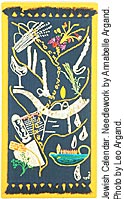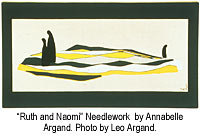Home | Search | The Artists | Teaching | Hiring | About This Site | Contact Us

Judaic Needlework
Madison, WI
Have you ever made art using fabric or thread? Those are the materials that Annabelle Argand used to make her art.
 |
Annabelle used different types of textiles in
different ways. One technique she used was called “finger sculpture.” She
formed shapes with colored pieces of fabric to make wrinkles that look like land forms. Then she
arranged those pieces on a
larger piece of fabric. The ![]() needlework above represents
what Annabelle saw when she visited the Beit Shemesh cave in Israel.
needlework above represents
what Annabelle saw when she visited the Beit Shemesh cave in Israel.
 |
Another technique Annabelle used was stitching pictures with colored thread. She used different methods to stitch the thread, such as embroidery, bargello, appliqué, and crewel. In this piece, Annabelle used different types of stitches to show an underwater scene from the south of Israel.
Working with textiles it is not like working with paint or clay. Annabelle had to place her thread at the exact spot she wanted it. She started with the shades of colors she wanted in the fabric or thread. If Annabelle wanted to move her colors, she didn’t use a brush. She had to take the thread out of the cloth and move it.
The Big Picture
Annabelle’s art is part of a tradition called Judaic art. Judaic art is art that represents important ideas in the Jewish faith. It can be both historical and contemporary. It can be made by people who have learned art in school and by people who have no formal art education. It can be made from many different types of material: textiles, paint, metal, glass, and wood. The art can be used in ceremonies in the synagogue or for decoration in the home. The common thing about Judaic art is that it is inspired by important ideas in the Jewish faith.

![]() The embroidery to the right is
Annabelle’s interpretation of the Jewish calendar. Click the
The embroidery to the right is
Annabelle’s interpretation of the Jewish calendar. Click the ![]() “Fun” icon to explore more about
this example of Judaic art.
“Fun” icon to explore more about
this example of Judaic art.
Stories in Cloth
Some of Annabelle’s Judaic art is based on stories from the Torah. Annabelle retold those stories in fabric and thread. Sometimes the way Annabelle told the stories was representational, meaning that she used symbolic colors and forms.

![]() Let’s look
at the representational piece to the left. Annabelle called it “Acharei Hamabool” or “After the Flood.” The story tells how a great flood covered the earth with water. Then, a man named Noah built an
ark and took with him two of every kind of animal. After forty days, the water went away and a rainbow came out. Noah sent out a dove to find land and it came back with an olive branch to show that
trees were growing again.
Let’s look
at the representational piece to the left. Annabelle called it “Acharei Hamabool” or “After the Flood.” The story tells how a great flood covered the earth with water. Then, a man named Noah built an
ark and took with him two of every kind of animal. After forty days, the water went away and a rainbow came out. Noah sent out a dove to find land and it came back with an olive branch to show that
trees were growing again.
Look at the bright colors on the right. They represent the rainbow. Then, see the white on the top? It represents a
dove and the green represents the olive branch. The shades of blue show the
![]() flooding waters going away. Representational images can
sometimes be more powerful than realistic ones. Try it in your own art!
flooding waters going away. Representational images can
sometimes be more powerful than realistic ones. Try it in your own art!
Ruth, Naomi and Orpah
 One of Annabelle’s most popular stories in cloth is the image on the right, taken from “The Book of Ruth.”
Annabelle used appliqué to tell the story of Ruth, Naomi and Orpah, three women who lived long ago in Moab (a part of Jordan). The story tells how Ruth decides to move back to Israel. Her
daughter-in-law Orpah decides to stay in her homeland, Moab. Naomi, her other daughter-in-law, decides to leave her home and go with Ruth to Israel, to help care for her. The story is about choosing
between leaving someone you love or leaving your home to go to a new and strange place.
One of Annabelle’s most popular stories in cloth is the image on the right, taken from “The Book of Ruth.”
Annabelle used appliqué to tell the story of Ruth, Naomi and Orpah, three women who lived long ago in Moab (a part of Jordan). The story tells how Ruth decides to move back to Israel. Her
daughter-in-law Orpah decides to stay in her homeland, Moab. Naomi, her other daughter-in-law, decides to leave her home and go with Ruth to Israel, to help care for her. The story is about choosing
between leaving someone you love or leaving your home to go to a new and strange place.
Looking at this picture, can you think of a time in your own life when you had to make a choice similar to Ruth, Naomi and Orpah’s?

For Educators:
“At the moment I put the needle into the cloth is when it begins.”
– Annabelle Argand
Home | Search | The Artists | Teaching | Hiring | About This Site | Contact Us
